
Guests
- Ryan DevereauxDemocracy Now! reporter who has been closely following Occupy Wall Street.
- Julie Gonzalesdirector of organizing for the Colorado Immigrant Rights Coalition
It was a month ago today that Occupy Wall Street began in Manhattan’s Financial District. The protest encampment based at Zuccotti Park remains and continues to grow despite last week’s threatened eviction by the City of New York. On Saturday, thousands of protesters marched from Zuccotti Park to Times Square, the heart of New York’s media, tourism and entertainment district. Earlier in the day, about two dozen people were arrested at a Citibank in Lower Manhattan while they attempted to take their money out of the bank. We speak to Ryan Devereaux, a Democracy Now! reporter who has been closely following the Occupy Wall Street movement. We also speak with Julie Gonzales, director of organizing for the Colorado Immigrant Rights Coalition, about the Occupy Denver protests. [includes rush transcript]
Transcript
AMY GOODMAN: That was music by the rhythm and blues singer Bo Diddley. Bo Diddley’s 56-year-old son Elias Anthony McDaniel was arrested for trespassing in the downtown Gainesville, Florida, plaza named for his father. At least four members of the Occupy Gainesville movement, including McDaniel, were arrested Friday morning for trespassing on the Bo Diddley Community Plaza after the park closed. The demonstration was peaceful, and the protesters said they decided to get arrested to prove a point. “This is my father’s park,” said McDaniel, a Gainesville resident. He said, “For them to arrest me in that plaza is ludicrous… I’m an American. This is freedom of assembly.” He was carrying a sign that said, “Hope isn’t just for presidents.”
And here in New York, at least 92 people were arrested on Saturday during a day of action that saw tens of thousands march from the Wall Street—Occupy Wall Street encampment to Times Square.
Earlier in the day, about two dozen people were arrested at a Citibank in Manhattan while they attempted to take their money out of the bank. The protesters were reportedly locked into the bank and then detained. Video shot outside the bank shows undercover police officer dragging a woman into the bank.
UNDERCOVER POLICE OFFICER: You were inside. You were inside with everybody else.
CUSTOMER: I’m a customer. I’m a customer.
WITNESS 1: She is a customer.
CUSTOMER: I’m a customer.
UNDERCOVER POLICE OFFICER: You were inside. Yes, but you were inside with the whole—no, no, no.
WITNESS 2: What are you doing?
WITNESS 1: Hey, what the—hey!
WITNESS 3: What are you doing? What are you doing? What are you doing? This is all being documented right now. She’s not doing anything! She’s not doing anything wrong! Oh, my god! This is wrong! This is wrong! This is wrong! What you’re doing is wrong! This is wrong! You should be ashamed of yourself! Shame! Shame! Shame!
AMY GOODMAN: And police arrested dozens of Occupy Wall Street protesters in Times Square on Saturday night. Many of the people who attended the demonstration were new to this type of activity. I bumped into one woman who was speaking right next to the barricades to contain the crowd. And then there was another activist who had been a longtime activist but not part of a movement.
PROTESTERS: Whose streets? Our streets! Whose streets? Our streets! Whose streets? Our streets! Whose streets? Our streets!
RITA HARRIS: Rita Harris. I’m from Brooklyn, and I’m here supporting the protesters. You know, I’ve followed it from the beginning. I just—you know, I just didn’t come. And I’m not a protester. I’ve never done this before, so this is my first time at a political-type event, so…
The bankers got their bailout, but the average American is still struggling. You know, unemployment is high, and people just—you know, people don’t see a way out of this mess. And they’re profiting right now, and we’re still here looking for jobs. I think that’s the bottom line. I think people are just frustrated and don’t see any progress and don’t see their lives changing.
JORDAN FULLAM: My name is Jordan Fullam. I’m a doctoral student at New York University. I study history and philosophy of education. I’ve been involved in organizing and activism for a little while before this. But usually, before Occupy Wall Street, people go out and protest, they have their signs, they have their chants, and then they pick up their stuff and go home. But this is the first time that there’s been a real movement, in my lifetime, where we see the same people coming out day after day. We see labor unions and student groups and other community organizing groups come together. And they stay. They keep coming back. They’re keeping up the fight. So it’s something that in my life I feel has no precedent.
PROTESTERS: We are the 99 percent! We are the 99 percent! We are the 99 percent!
AMY GOODMAN: Some of the voices from Occupy Wall Street, protesters here in New York, as they marched to Times Square in a global day of demonstrations backing their month-long campaign against economic inequality.
For more about the events in New York, we’re joined by Ryan Devereaux, Democracy Now! reporter who’s been closely following Occupy Wall Street.
Ryan, we were together at 46th Street and Times Square. It was a scene of tremendous tension through the evening that shifted. Talk about the police on horseback.
RYAN DEVEREAUX: Well, we were located at a sort of flash point in the confrontation between the protesters and the police at Times Square. There was a barricade line in front of us that prevented the demonstrators from entering into the main strip that most people would recognize as Times Square. This was hundreds and hundreds of people backed up at this point. The police were attempting—
AMY GOODMAN: Just in that area. There were thousands of people in Times Square.
RYAN DEVEREAUX: Just in that area alone. Thousands were—you’re correct. Thousands were in the area of Times Square. But in that intersection where we were, hundreds and hundreds of people were backed up, as far you could see. The police were attempting to push that barricade line back into the crowd. Some officers physically picked up the metal barricades and used them as shields, pushing back into the crowd.
Tensions reached a boiling point when the barricades were opened, and the police allowed officers on horseback to enter into the crowded space. Admittedly, some people chose to stand their ground as the NYPD repeatedly told them to back off, but those who wanted to move really couldn’t. There was no space to get away. And these horses were pushed into the crowd. I eyewitnessed one officer actually spurring his horse into the people. Demonstrators were terrified. They were screaming. One young woman next to me was saying over and over again, “You’re going to kill somebody!” At one point, one of the horses went down, and it was near pandemonium. People couldn’t believe it, and I couldn’t believe it.
AMY GOODMAN: The horse went down on its knees.
RYAN DEVEREAUX: Yes, that’s correct.
AMY GOODMAN: Almost as if it didn’t want to charge the crowd.
RYAN DEVEREAUX: Yeah, the horses actually did seem resistant to being pushed into this massive crowd of people. I mean, it was bright lights, loud noises, and nowhere for the people to go. I saw one young woman whose nose was literally up against the chest of a horse. I don’t understand, and didn’t understand at that moment and continue to not understand, what the NYPD was trying to do.
AMY GOODMAN: And what was particularly frightening about this area, at 46th and Broadway, was there were two large steam pipes that could fall over at any point. It was funneling the steam about 10 feet up so that it wouldn’t burn people from the ground, the ground extremely hot. People were being pushed back into those plastic steam protectors.
RYAN DEVEREAUX: Yes, that’s absolutely—it’s absolutely correct. It was dangerous on a number of levels: just the sheer amount of people; the horses, which are unpredictable, in that crowd where no one could get away; and then these teetering towers of steam.
AMY GOODMAN: And then talk about the barricades.
RYAN DEVEREAUX: Correct. As I mentioned, the officers would at times pick up the barricades. You know, six or so officers would pick up the barricades by their uprights and use them as sort of broad shields and push them into the crowd. There was one point when there was a metal piece of the barricade that had stuck out perpendicular, and that was shoved into the crowd right near where I was standing. It stopped just short of my stomach. I told the officers that this is dangerous. They really could have hurt somebody there.
AMY GOODMAN: And, of course, because of the number of people, the thousands of people in Times Square, those at the very front, where we were, at the front of the barricade, there was absolutely nowhere to go when the police said, “Move back,” and started pushing back, and when the horses were there.
RYAN DEVEREAUX: That’s exactly the issue, is that there was no place for these people to go. Even though the NYPD was saying, “Move back, move back,” there was no way to move back. It was a sea of people.
AMY GOODMAN: It was extremely tense. It looked like there were going to be even more arrests in this area. The police were moving in en masse, until the four-star commander came out.
RYAN DEVEREAUX: Yes, that’s correct. Joseph Esposito, as I understand it, the highest-ranking uniformed officer in the NYPD, came in, and he called the officers back from the line. They took about three steps back. And—
AMY GOODMAN: I mean, this was an amazing moment—
RYAN DEVEREAUX: It was an incredible moment.
AMY GOODMAN: —because it looked like he was coming forward to tell the police to move forward, and instead, he told the police to back off, to many of the police’s shock. You saw them looking at each other: “You’re telling us to move back?” And he said, “Yes, move back.”
RYAN DEVEREAUX: It really was an incredible moment. And the decision was met with, you know, huge applause from the crowd. They started chanting, “I love you.” And it was a really refreshing—
AMY GOODMAN: Well, they actually started chanting, “Police are the 99 percent.”
RYAN DEVEREAUX: Yes, they did. And it was a refreshing glimpse at what these confrontations could look like. Esposito responded in a civil way to civil disobedience, and I think that’s key.
AMY GOODMAN: And within minutes, the entire confrontation was over. People weren’t there to protest the police, the people we were speaking to. They were there to express a point about inequality. And once the police backed off, the whole thing dissipated so quickly.
RYAN DEVEREAUX: Yeah, it deflated incredibly rapidly after Esposito intervened in that way. And it really goes to show how these things could proceed in a different way, if there isn’t an expectation of violence or an expectation of confrontation, if the police actually work with and understand that these people aren’t out there—I’ve seen a number of these demonstrations. These aren’t violent protesters. They’re not seeking to damage public property or hurt the public. They just want to express their grievances.
AMY GOODMAN: The day started by people marching from Occupy Wall Street. This was right after the day before, where the park was going to be, quote, “cleaned up.” Many were fearful it was be cleaned out, and there was such a tremendous response, including from city officials, telling the Mayor, Bloomberg, to back off and not allow this private company that runs the park, Brookfield Properties, to move in with so-called cleaners, that at 7:00 in the morning, the appointed time of the evacuation, the city announced they would not be doing this evacuation. The next day, the protest began in the morning.
RYAN DEVEREAUX: That’s correct. The Occupy Wall Street movement here in New York City took part in the global day of action with a number of symbolic demonstrations throughout Manhattan. They began with a march in the Financial District, which led to a march to Washington Square, which is just north of the area, where they were bolstered by several hundred students protesting things like student debt. This leg of the march, I should say, was remarkably peaceful. I saw lead organizers cooperating with senior NYPD officials to determine the route of the procession. It was at Washington Square Park that a number of demonstrators broke off and went to Citibank, as we mentioned in the lede and the headlines, where they attempted to close their accounts with Citibank. Two dozen were arrested.
AMY GOODMAN: An amazing scene of a young woman who’s outside the bank, and the plainclothes officers drag her into the bank to be arrested.
RYAN DEVEREAUX: It is incredible. It appears that the woman did try to actually exit the bank and was pulled back in, in order to be arrested. The way that the police would respond when the protesters would pass banks was very interesting. At one point, as we were passing a Chase bank on Sixth Avenue, I saw a woman attempting to leave, and as—leave the bank. She was inside withdrawing money. And as the procession passed, an officer stood in front of the door and slammed it shut on her. She couldn’t get out. I met up with her later. I saw her later, and she was shocked.
AMY GOODMAN: Well, as we talk about what’s happening here, I wanted to bring in a member of the Occupy Denver protest, where police cleared Occupy protest in Veterans Park near the State Capitol. Thousands of people gathered to reclaim the space on Saturday. Later that night, officers reportedly pepper-sprayed, arrested several protesters who kept their kitchen tents erected in the park.
For more, we go to Julie Gonzales, director of organizing for the Colorado Immigrant Rights Coalition.
Julie, we just have a minute. Can you talk about the Occupy Denver movement that’s been going on for a few weeks now?
JULIE GONZALES: Absolutely. We’ve been occupying Lincoln Park, right next to the State Capitol, since September 17th. On Thursday night, Governor John Hickenlooper announced that he was going to clear the park that night/morning between Thursday night and Friday morning. At about 3:15 in the morning, riot police moved in and cleared all the tents, and at about 7:30, then, on Friday morning, arrested 24 people for the kitchen that had been set up that was serving over 400 meals a day. And so, the very next day, that Friday, you know, hundreds of people came back, donating more food in order to reestablish our kitchen, and we ended up taking up the park that’s right next to Lincoln Park, the Civic Center Park. And then, Saturday, it was just beautiful to see how many people came out in order to help us reclaim that public space. And so, while, you know, the Denver Police Department, Colorado State Patrol, had, you know, armed guards all around Lincoln Park, Civic Center Park we had open.
Five thousand people marched downtown on Saturday over—throughout the financial district of Denver, as well as the 16th Street Mall, which is a public, open-space mall right in the heart of downtown. And, you know, incredibly peaceful, incredibly, I think, you know, well organized. And yet, what we saw is that, that evening, again, riot police moved in, took down the kitchen a second time. Another 24 people were arrested. And this time they actually used pepper spray on protesters. We have reports that, you know, even traditional news media folks were pepper-sprayed, were in melee that ensued. And so, you know, I think that—
AMY GOODMAN: So, what are your plans now, Julie? We have just 10 seconds. Your plans now? What is Occupy Denver doing?
JULIE GONZALES: We are going to continue to organize. We’re going to continue to occupy. And we’re going to continue to stand in solidarity with all the other Occupies across the world.
AMY GOODMAN: We want to thank you for being with us, Julie Gonzales, organizing with Colorado Immigrant Rights Coalition, part of Occupy Denver.
And back on Wall Street, just to say, though we talked about the de-escalation in Times Square, in fact, Ryan, there were many who were arrested afterwards as they were leaving and going to Washington Square Park on their way back down to the encampment at Occupy Wall Street.
RYAN DEVEREAUX: That’s true. They held a general assembly. The protesters held a general assembly at Washington Square Park after the incident at Times Square. Some members, a minority of members, elected to stay in the park and were subsequently arrested by the NYPD, approximately 14 protesters.
AMY GOODMAN: We’re going to leave it there, but of course continue to cover the Occupy Wall Street movement in New York and around the United States and around the world.

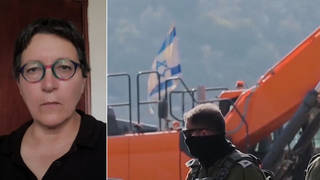
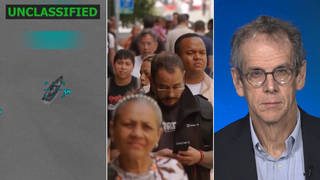
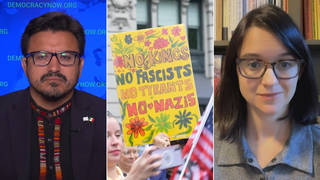
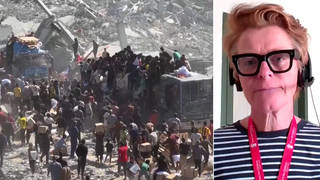





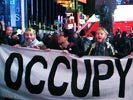
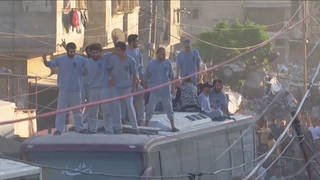
Media Options